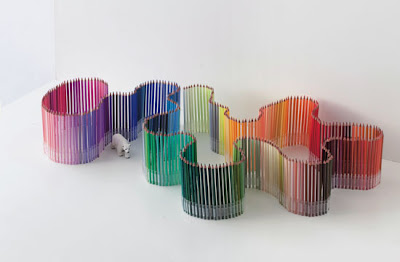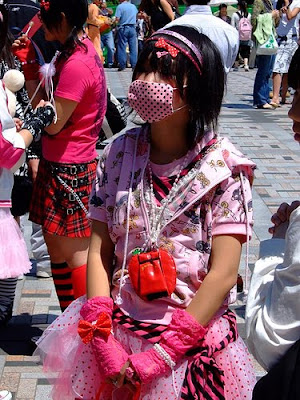Imagine you're a teenager living in Japan...
After a week forced to dress in school uniforms, how would you unwind? Jeans? T-shirts? Maybe a comfy sweatshirt?
Think again.
 image source
image source
If you're a kid in Harajuku, Japan, how about like this?
Imagine how fun it would have been to be a teenager growing up in a culture that encouraged such over the top self-expression and individuality.
um, is that a fingernail?
Harajuku (hara-joo-koo) is the common name for the area around Harajuku Station on the Yamanote Line in Tokyo, Japan where young people gather every Sunday, dressed in a variety of styles that include gothic lolita, visual kei, cosplay (short for costume play), rockabilly, hip-hop, and punk. Beginning in the 80's, the area was closed to traffic on Sundays, and people would gather, play music, and socialize.

Photographer Shoichi Aoki, credited with bringing street fashion to Japan, started a magazine called Street in the 1980's to show Japanese kids the ‘free street art’ of London. Aoki says, "In the mid 90’s it was truly revolutionary when people started to dye their hair and choose their own color. You eventually saw all kinds of colors: green, red, anything.”
He continues,“You had this small group of trendsetters, perhaps 10 to 20 people. Whenever they came up with something new, others would soon imitate them. But these imitators weren’t as cool as the original trendsetters so the trendsetters didn’t want to be identified with them. To differentiate themselves again they came up with new things.
It just escalated. They kept on trying to escape from their imitators right into “decora” (lots of decorative doodads and strong bright colors). They figured nobody would follow them into wearing clothes that crazy.”
But what do these clothing statements mean? Aoki says there is no social context at all. "Instead of expressing yourself, it is a way of communicating with the members of your group. A message without words. You show your feelings, your awareness of fashion... They don’t care at all about how other people in society or how other groups see them.” (
source)
I don't know about that. Posing on the Harajuku bridge for tourists, I've read that these teens clamber to be snapped by magazine photographers hanging out in the crowd.
So what are these subsets of Harajuku street fashion?
Goth Lolitas wear black and white, or shades of pastel if they're being "sweet". Lots of knee length or mini dresses gooped-up with crinoline, lace, corsets, ribbons....
Accessories are an important key ingredient: frilly aprons, stockings, thigh-highs or knee socks, dolls, tiny top hats or bonnets, and handbags .
Occasionally, you'll see a guy dressed up, too.
Decora is a style of dress hyper-decorated with tiny toys and plastic jewelry, usually in bright crayola crayon colors. Related, but not as extreme is the
Kawaii or "cuteness" style; girls wear clothing that appears to be made for young children, or dress to look "Japanese cute".
This style is adopted mainly by young Japanese girls. Think pink and plastic-lots and lots of it.
Ultra modern looking punk Visual Kei is inspired by the local music scene, especially punk and rock. The look is often androgynous. This girl is playing the bassist from a japanese rock band. What's with the nose cover? Guess it's his trademark, like MJ's glove in the 80's.
 image source
image source
Cosplay referred to role playing in costumes. Anime characters, manga, rock-stars, computer or video game characters...you name it.
This genre runs the gamut. Punk rock fairies, anyone?
Side note: In many of the photos I browsed through, I noticed many people wear face masks. Some just regular hospital-issue, and others quite elaborate. With a little digging, I discovered these masks are commonplace in Japan.
Out of consideration, if you are sick, you wear a mask to keep your germs -in-. It also helps during allergy season. Bizarre concept to us Westerners, but a
widely accepted culture in Japan.
Okay, back to the Harajuku...
The key seems to be layering. Layer, layer, layer. Stripes with polka dots, every color in the rainbow, several pairs of socks... Everything from designer clothes to handmade is mixed and mismatched (key ingredient here) with colorful accessories to create a unique and individual style.
Singer, designer, entrepreneur Gwen Stefani has jumped on the Harajuku bandwagon, with a fragrance called
Harajuku Lovers, and a clothing line. Harajuku Lovers focuses specifically on '
Kawaiiness', or "cuteness".
 image source
image source
It's even gone rather mainstream, with clothing retailers selling Harajuku "sets'. This one is called the "Harajuku Girl Glamorous Punk Set"
This pop culture trend has actually been quite widely accepted throughout Japan on every level, even seen by some as part of their national identity.
Think: Pikachu or Hello Kitty. Yup, those are indeed airplanes. I kid you not.

Want to see more? For even more colorful pictures of Harajuku, check out Shoichi Aoki's books
Fruits,
Fresh Fruits or his
magazine of the same name.
So the next time you are fretting about being seen in one navy sock and one black, or worry that your shirt might be a bit too colorful, think of the Harajuku kids and be brave!
 She created these beauties specially for one lucky Hue reader. Aren't they fabulous? Wish I could participate...
She created these beauties specially for one lucky Hue reader. Aren't they fabulous? Wish I could participate... How about a little about the artist first? Katie is a graduate student in Louisiana. In her free time, she makes jewelry from vintage and up-cycled materials. She's especially inspired by the color and motion of different pieces. In Katie's own words:
How about a little about the artist first? Katie is a graduate student in Louisiana. In her free time, she makes jewelry from vintage and up-cycled materials. She's especially inspired by the color and motion of different pieces. In Katie's own words:
 image source
image source The winner will receive these earrings featuring two vintage sapphire glass navette jewels, vintage beads with a lovely patina, and hand-oxidized brass chain and earwires. Elegant for daytime or evening.
The winner will receive these earrings featuring two vintage sapphire glass navette jewels, vintage beads with a lovely patina, and hand-oxidized brass chain and earwires. Elegant for daytime or evening.















































